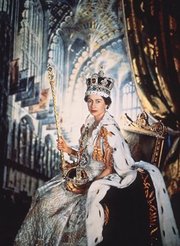Crown (headgear)
|
|
| This article is part of the hats and headgear series: |
| Overview of headgear |
| Hats; Bonnets; Caps |
| Hoods; Helmets; Wigs |
| Masks; Veils; Scarves |
| Tiaras; Papal tiaras |
| Crowns; Types of crowns |
| List of hats and headgear |
A crown is a symbolic form of headgear worn by a monarch or by a god, for whom the crown is traditionally one of the symbols of legitimacy (See Regalia for a broader treatment). In Byzantine and European cultures, where ecclesiastical sanction authenticates monarchic power, when a new monarch assumes the throne in a coronation ceremony, the crown is placed on the new monarch's head by a religious official. Some, though not all early Holy Roman Emperors travelled to Rome at some point in their careers to be crowned by the pope. Napoleon, according to legend, surprised Pius VII when he reached out and crowned himself, although in reality this order of ceremony had been pre-arranged: see Coronation.
The precursor to the crown was the browband called the diadem (see Diadem), which had been worn by the Achaemenid Persian emperors, was adopted by Constantine the Great, and was worn by all subsequent rulers of the later Roman Empire.
The corona radiata, the "radiant crown" known best on the Statue of Liberty, and perhaps worn by the Helios that was the Colossus of Rhodes, was worn by pagan Roman emperors, part of the cult of Sol Invictus. It was referred to as "the chaplet studded with sunbeams” by Lucian, about 180 AD (in Alexander the false prophet (http://www.tertullian.org/rpearse/lucian/lucian_alexander.htm)).

Today, only the British Monarchy continues this tradition as the sole remaining anointed and crowned monarch, though many monarchies retain a crown as a national symbol in heraldry. The French Crown Jewels were sold in 1885 on the orders of the Third French Republic, with only a token number, with their precious stones replaced by glass, held on to for historic reasons and displayed by the Louvre. The Spanish Crown Jewels were destroyed in a major fire in the eighteenth century while the Irish Crown Jewels were stolen from Dublin Castle in 1907.
Similar headgear, worn by nobility and other high ranking people below the ruler, is the coronet.
Special headgear to designate rulers dates back to pre-history, and is found in many separate civilizations around the globe. Commonly rare and precious materials are incorporated into the crown. Gold and precious jewels are common in crowns. In the Native American civilizations of the Pre-Columbian New World, rare feathers, such as that of the quetzal, often decorated crowns.
In Classical antiquity the crown (corona) that was sometimes awarded to people other than rulers, such as triumphal military generals or athletes, was actually a wreath or chaplet, or ribbonlike diadem.
As an emblem
J23t.jpg
A Crown is often an emblem of the monarchy, a monarch's government, or items endorsed by it; see The Crown. A crown or coronet is employed in heraldry under strict rules.
Costume headgear imitating a monarch's crown is also called a crown. Such costume crowns may be worn by actors portraying a monarch, people at costume parties, or ritual "monarchs" such as the king of a Carnival krewe, or the person who found the trinket in a king cake.
The Eastern Orthodox marriage service has a section called the crowning, wherein the bride and groom are crowned as "king" and "queen" of their future household. In Greek weddings, the crowns are usually made of flowers (synthetic or real) and are kept by the couple as a reminder of their special day. In Slavic weddings, the crowns are usually made of metal and designed to resemble a monarch's crown, and a parish usually owns one set to use for all the couples that are married there since these are much more expensive than Greek-style crowns.
MuralCrownStamp1953.jpg
Children, generally girls, sometimes connect flowers together in chain, and wear the wreath as if it was a crown (illustration, left).
See also
- Diadem (personal wear)
- tiara
- papal tiara
- crown jewels
- List of Royal Crownsda:Krone (hovedbeklædning)
de:Krone it:Corona (copricapo) no:Krone (hodebekledning) pl:Korona (atrybut)

